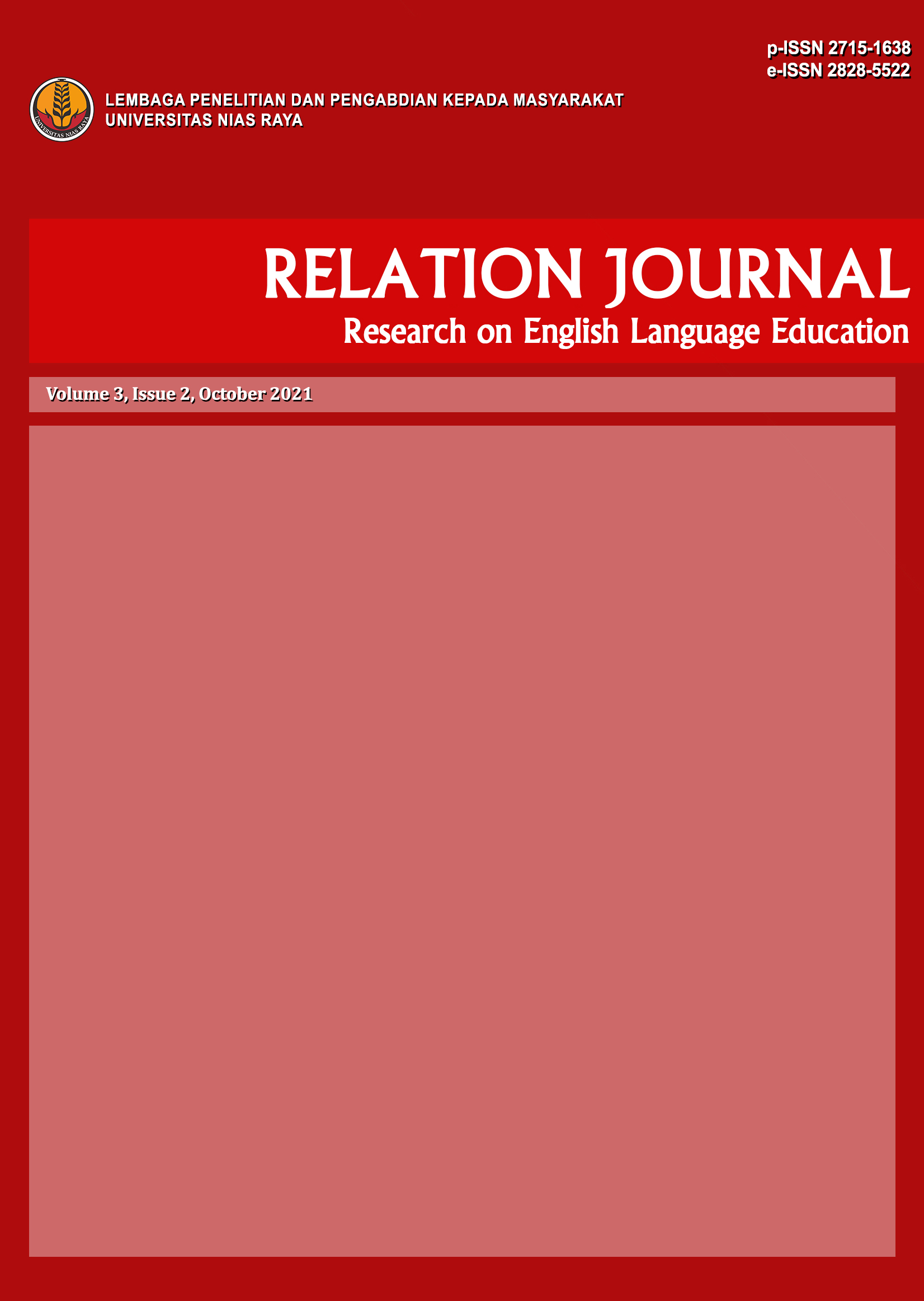DEIXIS IN JOHN GREEN’S NOVEL ENTITLED LOOKING FOR ALASKA
Abstract
This thesis studies the use of deixis that occurred in John Green’s novel entitiled Looking for Alaska. The objectives of this research are classifying the types of deixis found in John Green’s novel Looking for Alaska and describing how the deixis use in John Green’s novel Looking for Alaska. In this research, the researcher used the deixis, theory, namely person deixis, temporal deixis, spatial deixis, discourse deixis, and social deixis. This study used qualitative methods with descriptive approach. The data of this research was the utterance or sentence containing deixis that occurred in John Green’s novel Looking for Alaska. In analyzing the data, the researcher used the theory of Levinson. The result of analysis shows that there are five types of deixis in John Green’s novel, they are person deixis, temporal deixis, spatial deixis, discourse deixis, and social deixis. The person deixis found in sentence and utterance in novel Looking for Alaska are I, us, me, you, your, we, my, him, her, she, he, they, them, their, our, herself, myself, himself, themselves, and yourself. The spatial deixis found in the utterance novel Looking for Alaska are here and there. The temporal deixis found in the utterance in novel Looking for Alaska is now, then, last year, that evening, yesterday, today, to night, last night, the afternoon, next morning, next time, tomorrow, last week, and next day”. The discourse deixis found in utterance in novel Looking for Alaska is this, that, these, and those. Then, the social deixis found in utterance in novel Looking for Alaska is American President. the analysis of this research shows that the deixis used in the novel does not have the same reference. It depends on the context and situation of scene in the novel. Therefore, the readers must know the context and the situation of the novel in order to understand the reference of deitic words. Hopefully the findings of this study could be useful in providing understanding on deixis theory.
References
Berg, Bruce I. 2001. Qualitative Research methods for the Social Sciences (4th Ed). California: Ally and Bacon.
Crawford, E. marion. 1893. The novel: What it is. Boston: Macmilan and Co.
Griffiths, Patrick 2006. An introduction to English Semantics and pragmatics. Edinburgh University Press.
Grundy, Peter. 2000. Doing Pragmatics. New York: Oxford University Press
Horn, R. Laurence and Gregory Ward. 2006. The Handbook of Pragmatics. Blackwell Publishing Ltd.
John Green. 2005. Looking for Alaska. United States of America: Dutton Books.
Kennedy, X. J. 1966. Literature: An Introduction to Fiction, Poetry, and Drama. Canada: Little, Brown and Company.
Klarer, Mario. 2004. An Introduction to literary Studies (2nded). USA & Canada: Routledge.
Krippendorff, Klaus. 2004. Content Analysis: An Introduction to its Methodology. California: Sage Publication.
Levinson, Stephen C. 1983. Pragmatics. New York: Cambridge University Press.
Lincoln, Yvonna S. and Guba, Egon G. 1985, Naturalistic Inquiry. California: Sage Publication, Inc.
Mey, Jacob I. 2001. Pragmatics: An Introduction (2nd Ed). Australia: Blackwell.
Miles, M. & Huberman, A. 1994. Qualitative Data Analysis.(2nd Ed). California: Publication, Inc.
Vanderstoep, S.W., and Johnstop, D. 2009. Research Method for Everyday Life. Jossey-Bass.
Yule, George. 1996. Pragmatics. New York: Oxford University Press.
Herman,&HilmanPardede. 2020. Deixis Analysis in the Business Article of Jakarta Post, Journal BahasadanSastra, (Online), Vol. 12, No. 2, (https://doi.org/10.31294/w.v12i1, accessed September 2020). Hal.137-141.
Laia, Yunus. 2020. Deixis in Charles Dicken’s Great Expectation, Journal Education and Development InstitutPendidikanTapanuli Selatan, (Online), Vol. 8, No. 2, Accessed Mei 2020. Hal.332-335.
Yulfi. 2017. An Analysis of Deixis and Speech Act used in English and Learning process, Journal of Linguistics, English Education and Art, (Online), Vol. 1, No. 1, Accessed December 2017. Hal.82-90.
Source of Internet
https://www.seputarpengetahuan.co.id
You are free to:
- Share — copy and redistribute the material in any medium or format for any purpose, even commercially.
- Adapt — remix, transform, and build upon the material for any purpose, even commercially.
- The licensor cannot revoke these freedoms as long as you follow the license terms.
Under the following terms:
- Attribution - You must give appropriate credit , provide a link to the license, and indicate if changes were made . You may do so in any reasonable manner, but not in any way that suggests the licensor endorses you or your use.
- No additional restrictions - You may not apply legal terms or technological measures that legally restrict others from doing anything the license permits.
Notices:
- You do not have to comply with the license for elements of the material in the public domain or where your use is permitted by an applicable exception or limitation.
- No warranties are given. The license may not give you all of the permissions necessary for your intended use. For example, other rights such as publicity, privacy, or moral rights may limit how you use the material.









